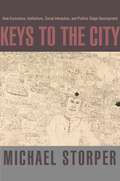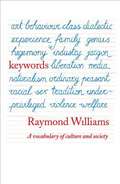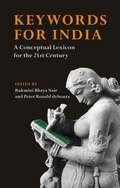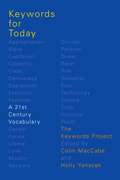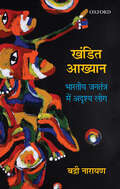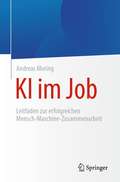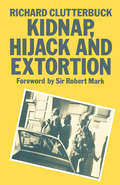- Table View
- List View
The Keys to Kindness: How to be Kinder to Yourself, Others and the World
by Claudia HammondKindness can be your super-power. It feels good to be kind to others. And it feels good to receive kindness. Making the world better, in however small a way, feels good and does good. Did you know kinder bosses are more successful bosses? That paying it forward can help build a purpose-driven life? Being kind strengthens relationships. Acts of kindness, whether given or received, improve our mental and physical health. Drawing on the latest research from psychology and neuroscience, and her work in collaboration with the University of Sussex and the BBC, Claudia Hammond sets out a prescription for a kinder life that you can adapt to your own circumstances, and explains how to use this guidance for ourselves, others and the world. It’s time for a kindness revolution.
Keys to the City: How Economics, Institutions, Social Interaction, and Politics Shape Development
by Michael StorperWhy do some cities grow economically while others decline? Why do some show sustained economic performance while others cycle up and down? In Keys to the City, Michael Storper, one of the world's leading economic geographers, looks at why we should consider economic development issues within a regional context--at the level of the city-region--and why city economies develop unequally. Storper identifies four contexts that shape urban economic development: economic, institutional, innovational and interactional, and political. The book explores how these contexts operate and how they interact, leading to developmental success in some regions and failure in others. Demonstrating that the global economy is increasingly driven by its major cities, the keys to the city are the keys to global development. In his conclusion, Storper specifies eight rules of economic development targeted at policymakers. Keys to the City explains why economists, sociologists, and political scientists should take geography seriously.
Keys to the City: How Economics, Institutions, Social Interaction, and Politics Shape Development
by Michael StorperWhy do some cities grow economically while others decline? Why do some show sustained economic performance while others cycle up and down? In Keys to the City, Michael Storper, one of the world's leading economic geographers, looks at why we should consider economic development issues within a regional context--at the level of the city-region--and why city economies develop unequally. Storper identifies four contexts that shape urban economic development: economic, institutional, innovational and interactional, and political. The book explores how these contexts operate and how they interact, leading to developmental success in some regions and failure in others. Demonstrating that the global economy is increasingly driven by its major cities, the keys to the city are the keys to global development. In his conclusion, Storper specifies eight rules of economic development targeted at policymakers. Keys to the City explains why economists, sociologists, and political scientists should take geography seriously.
Keywords;: For Further Consideration and Particularly Relevant to Academic Life, &c.
by D. Graham Burnett a Community of Inquiry Matthew Rickard Jessica TerekhovAn irreverent critical lexicon of academic life and cultureThe university: The very name evokes knowledge, culture, and the magnificently universal ambition at the heart of this essential institution. Bastions of free inquiry and a free society, engines of social transformation and economic progress, enclosed gardens of ennobling reflection and creation, universities encompass the wisdom of the past and the hope of the future. Or do they? This critical glossary—written by a group of Princeton graduate students and faculty—defines fifty-eight terms common to academic life in a style that will prick both egos and consciences. From “academia” to “vocation,” “canon” to “peer review,” “discipline” to “methodology,” the book scrutinizes the often stultifying structures of modern disciplinary life, calls out a slavish devotion to “knowledge production” as the enemy of thought, and even dissects the notion of “academic excellence.” Feisty and darkly funny, passionate and deeply insightful, this book raises hard questions about teaching, research, theory, practice, and academic labor. The result is a must-read dispatch from today’s academic trenches—one that is sure to provoke discussion and debate.
Keywords;: For Further Consideration and Particularly Relevant to Academic Life, &c.
by D. Graham Burnett a Community of Inquiry Matthew Rickard Jessica TerekhovAn irreverent critical lexicon of academic life and cultureThe university: The very name evokes knowledge, culture, and the magnificently universal ambition at the heart of this essential institution. Bastions of free inquiry and a free society, engines of social transformation and economic progress, enclosed gardens of ennobling reflection and creation, universities encompass the wisdom of the past and the hope of the future. Or do they? This critical glossary—written by a group of Princeton graduate students and faculty—defines fifty-eight terms common to academic life in a style that will prick both egos and consciences. From “academia” to “vocation,” “canon” to “peer review,” “discipline” to “methodology,” the book scrutinizes the often stultifying structures of modern disciplinary life, calls out a slavish devotion to “knowledge production” as the enemy of thought, and even dissects the notion of “academic excellence.” Feisty and darkly funny, passionate and deeply insightful, this book raises hard questions about teaching, research, theory, practice, and academic labor. The result is a must-read dispatch from today’s academic trenches—one that is sure to provoke discussion and debate.
Keywords: A Vocabulary of Culture and Society (PDF)
by Raymond WilliamsRaymond Williams' seminal exploration of the history of meaning of some of the most important words in the English language. First published in 1976, and expanded in 1983, KEYWORDS reveals how the meanings of 131 words - including 'art', 'class', 'family', 'media', 'sex' and 'tradition' - were formed and subsequently altered and redefined as the historical contexts in which they were used changed. Neither a defining dictionary or glossary, KEYWORDS is rather a brilliant investigation into how the meanings of some of the most important words in the English language have shifted over time, and the forces that brought about those shifts.
Keywords for India: A Conceptual Lexicon for the 21st Century
by Peter Ronald DeSouza Rukmini Bhaya NairWhat terms are currently up for debate in Indian society? How have their meanings changed over time? This book highlights key words for modern India in everyday usage as well as in scholarly contexts. Encompassing over 250 key words across a wide range of topics, including aesthetics and ceremony, gender, technology and economics, past memories and future imaginaries, these entries introduce some of the basic concepts that inform the 'cultural unconscious' of the Indian subcontinent in order to translate them into critical tools for literary, political, cultural and cognitive studies. Inspired by Raymond Williams' pioneering exploration of English culture and society through the study of keywords, Keywords for India brings together more than 200 leading sub-continental scholars to form a polyphonic collective. Their sustained engagement with an incredibly diverse set of words enables a fearless interrogation of the panoply, the multitude, the shape-shifter that is 'India'. Through its close investigation and unpacking of words, this book investigates the various intellectual possibilities on offer within the Indian subcontinent at the beginning of a fraught new millennium desperately in need of fresh vocabularies. In this sense, Keywords for India presents the world with many emancipatory memes from India.
Keywords for India: A Conceptual Lexicon for the 21st Century
What terms are currently up for debate in Indian society? How have their meanings changed over time? This book highlights key words for modern India in everyday usage as well as in scholarly contexts. Encompassing over 250 key words across a wide range of topics, including aesthetics and ceremony, gender, technology and economics, past memories and future imaginaries, these entries introduce some of the basic concepts that inform the 'cultural unconscious' of the Indian subcontinent in order to translate them into critical tools for literary, political, cultural and cognitive studies. Inspired by Raymond Williams' pioneering exploration of English culture and society through the study of keywords, Keywords for India brings together more than 200 leading sub-continental scholars to form a polyphonic collective. Their sustained engagement with an incredibly diverse set of words enables a fearless interrogation of the panoply, the multitude, the shape-shifter that is 'India'. Through its close investigation and unpacking of words, this book investigates the various intellectual possibilities on offer within the Indian subcontinent at the beginning of a fraught new millennium desperately in need of fresh vocabularies. In this sense, Keywords for India presents the world with many emancipatory memes from India.
Keywords for Today: A 21st Century Vocabulary
by Colin Maccabe and Holly YanacekKeywords for Today takes us deep into the history of the language in order to better understand our contemporary world. From nature to cultural appropriation and from market to terror, the most important words in political and cultural debate have complicated and complex histories. This book sketches these histories in ways that illuminate the political bent and values of our current society. Written by The Keywords Project, an independent group of scholars who have spent more than a decade on this work, Keywords for Today updates and extends Raymond Williams's classic work, Keywords: A Vocabulary of Culture and Society. It updates some 40 of Williams's original entries and adds 86 new entries, ranging from access to youth. The book is both a history of English, documenting important semantic change in the language, and a handbook of current political and ideological debate. Whether it is demonstrating the only recently-acquired religious meaning of fundamentalism or the complicated linguistic history of queer, Keywords for Today will intrigue and enlighten.
Keywords for Today: A 21st Century Vocabulary
Keywords for Today takes us deep into the history of the language in order to better understand our contemporary world. From nature to cultural appropriation and from market to terror, the most important words in political and cultural debate have complicated and complex histories. This book sketches these histories in ways that illuminate the political bent and values of our current society. Written by The Keywords Project, an independent group of scholars who have spent more than a decade on this work, Keywords for Today updates and extends Raymond Williams's classic work, Keywords: A Vocabulary of Culture and Society. It updates some 40 of Williams's original entries and adds 86 new entries, ranging from access to youth. The book is both a history of English, documenting important semantic change in the language, and a handbook of current political and ideological debate. Whether it is demonstrating the only recently-acquired religious meaning of fundamentalism or the complicated linguistic history of queer, Keywords for Today will intrigue and enlighten.
Keywords in Criminology: A Cultural Dictionary
by Vincenzo RuggieroTaking inspiration from the classic text by Raymond Williams, Keywords in Criminology reflects on the language used by criminologists and offers a one‑stop guide to core concepts in the discipline. Written for the budding Criminology student, it offers a specialized but plain dictionary for a specialized discipline.From Abolitionism to Xenophobia, the entries unveil the ambiguities and conflicting interpretations of the concepts discussed, and explore their historical context, their analytical use, adoption or critical rejection. The original formulation of each concept is examined along with the practices the concept has shaped, and the favourable and unfavourable outcomes it has generated. Keywords in Criminology is a handy and pithy companion for any Criminology student. It offers excellent supplementary reading for core courses on criminological, social and cultural theory.
Keywords in Criminology: A Cultural Dictionary
by Vincenzo RuggieroTaking inspiration from the classic text by Raymond Williams, Keywords in Criminology reflects on the language used by criminologists and offers a one‑stop guide to core concepts in the discipline. Written for the budding Criminology student, it offers a specialized but plain dictionary for a specialized discipline.From Abolitionism to Xenophobia, the entries unveil the ambiguities and conflicting interpretations of the concepts discussed, and explore their historical context, their analytical use, adoption or critical rejection. The original formulation of each concept is examined along with the practices the concept has shaped, and the favourable and unfavourable outcomes it has generated. Keywords in Criminology is a handy and pithy companion for any Criminology student. It offers excellent supplementary reading for core courses on criminological, social and cultural theory.
Keywords In Youth Studies: Tracing Affects, Movements, Knowledges (PDF)
by Andy Furlong Susan Talburt Nancy LeskoWith recent attention to issues such as youth social exclusion, poverty, school underachievement, school violence, gang activity, sexuality, and youth#65533;s interactions with media and the internet, youth studies has emerged as a significant interdisciplinary field. It has moved beyond its roots in subcultural studies to encompass a diverse array of disciplines, subfields, and theoretical orientations. Yet no volume exists that systematically presents and puts into dialogue the field#65533;s areas of focus and approaches to research. As a unique blend of reference guide, conceptual dictionary, and critical assessment, Keywords in Youth Studies presents and historicizes the "state of the field. " It offers theoretically-informed analysis of key concepts, and points to possibilities for youth studies#65533; reconstruction. Contributors include internationally-renowned field experts who trace the origins, movements, and uses and meanings of "keywords" such as resistance, youth violence, surveillance, and more. The blending of section essays with focused keywords offers beginning and advanced readers multiple points of entry into the text and connections across concepts. A must-read for graduate students, faculty, and researchers across a range of disciplines, this extraordinary new book promotes new interdisciplinary approaches to youth research and advocacy.
Khandit Akhyan: Bharatiya Jantantra mein Adrishya Log
by Badri NarayanThere are two ways of looking at democracy. One is the view of the state, policymakers, and so on, which shows the dissemination and spread of democracy in statistical terms. The other view is the one from the bottom. This view helps us understand and grapple with the reality of the spread of democracy, and enables us to observe the groups and communities excluded from the process of democratic empowerment. Fractured Tales documents narratives of the voiceless and invisible dalit castes that have been left out in the 60 years of state-led Indian democracy. Exploring the deepening of democracy among the dalits of Uttar Pradesh, it argues that the process of democratization of these communities over-represents some groups such as the Chamars and Pasis while neglecting others like the Musahar, Bansphor, and Sapera communities. These ‘invisible’ communities are unable to assert their presence in the ever-evolving political contestation between multiple marginal groups. Delving into the politics of visibility, empowerment, and exclusion, the author captures the growing sense of disillusionment among marginalized dalit communities. This is the Hindi edition translated from English.
Kharkov/Kharkiv: A Borderland Capital
by Volodymyr KravchenkoKharkiv is Ukraine’s second largest city and its former capital. Situated within 40 km of the Ukrainian-Russian border it is one of those East-Central European “liminal” cities which became a center of modernization and pluralization in the borderland area, playing a prominent role in the process of nation building. Volodymyr Kravchenko’s expanded edition of Kharkov/Kharkiv, now in the English-language and including a new chapter on the reconfiguration of the Ukrainian-Russian borderland during and after the watershed Euromaidan event, uniquely uncovers the city’s long history, from the 17th century to today. Addressing issues of regional and national identities, Ukrainian-Russian relations, mental mapping, historical narratives and the ensuing de/reconstruction of national mythologies, this book, fills a unique gap in the literature on Kharkiv.
Kharkov/Kharkiv: A Borderland Capital
by Volodymyr KravchenkoKharkiv is Ukraine’s second largest city and its former capital. Situated within 40 km of the Ukrainian-Russian border it is one of those East-Central European “liminal” cities which became a center of modernization and pluralization in the borderland area, playing a prominent role in the process of nation building. Volodymyr Kravchenko’s expanded edition of Kharkov/Kharkiv, now in the English-language and including a new chapter on the reconfiguration of the Ukrainian-Russian borderland during and after the watershed Euromaidan event, uniquely uncovers the city’s long history, from the 17th century to today. Addressing issues of regional and national identities, Ukrainian-Russian relations, mental mapping, historical narratives and the ensuing de/reconstruction of national mythologies, this book, fills a unique gap in the literature on Kharkiv.
KI im Job: Leitfaden zur erfolgreichen Mensch-Maschine-Zusammenarbeit
by Andreas MoringDieses Buch ist ein praktischer Leitfaden für die Nutzung von Künstlicher Intelligenz mit motivierten Mitarbeitern in Unternehmen und Organisationen. Sie erfahren, was die Voraussetzungen dafür sind, dass Menschen sich auf eine produktive Zusammenarbeit mit „intelligenten Maschinen“ freuen können. Denn nur so kann das volle Potenzial von KI gehoben werden. Dazu erhalten Sie einen Überblick, wie und wo KI in Unternehmen eingesetzt werden kann und wie Sie die richtigen Einsatzfelder für KI in Ihrem Unternehmen identifizieren. Dabei geht es vor allem um die folgende Fragestellung: Welche Aufgaben übernimmt zukünftig die KI und welche sollen weiterhin von den Mitarbeiter/innen durchgeführt werden. Diese Entscheidungen verändern Prozesse und Aufgaben und erfordern praktisches Change Management und Motivation. In diesem Buch erfahren Sie, wie Sie Menschen für diese neuen Aufgaben motivieren und begeistern können, damit die Schritte zum Einsatz von KI im Arbeitsumfeld bestmöglich gelingen können. Zum Autor: Prof. Dr. Andreas Moring ist Professor für Digital Business, Innovation & AI an der International School of Management. Er ist Gründer und Leiter des JuS.TECH Instituts für KI und Nachhaltigkeit, Co-Gründer der Initiative WeGoFive für eine produktive Mensch-KI.Kooperation und Themenpate für Mensch-KI-Kooperation am Artificial Intelligence Center ARIC in Hamburg.
KI in der Psychologie - ist der Mensch eine Maschine? (essentials)
by Peter Gloor Marc SchreiberIm Buch wird die Frage diskutiert, ob der Mensch eine Maschine ist und ob Algorithmen der künstlichen Intelligenz (KI) das menschliche Erleben und Handeln jemals komplett abbilden können werden. Die Fragen werden sowohl aus der Perspektive der Psychologie als auch aus derjenigen der Informatik beleuchtet. Anhand von konkreten Projekten werden die Gemeinsamkeiten und Unterschiede der beiden Perspektiven erläutert und es werden Probleme sowie ethische Fragestellungen im Zusammenhang mit der Anwendung von KI-Algorithmen in psychologischen Anwendungsfeldern thematisiert.
Kibbutz Community and Nation Building
by Paula M. RaymanFocusing on the evolution of one border kibbutz from 1938 to the present, Paula Rayman explores the dynamics between internal community organization and external national and international forces.Originally published in 1982.The Princeton Legacy Library uses the latest print-on-demand technology to again make available previously out-of-print books from the distinguished backlist of Princeton University Press. These editions preserve the original texts of these important books while presenting them in durable paperback and hardcover editions. The goal of the Princeton Legacy Library is to vastly increase access to the rich scholarly heritage found in the thousands of books published by Princeton University Press since its founding in 1905.
The Kibbutz Industry: Cultural, Structural and Business Strategy Design (Routledge Studies in the Sociology of Work, Professions and Organisations)
by Yaffa MoskovichThis book examines the changes in many kibbutz factories which have recently transformed from socialist entities, with egalitarian and cooperative relationships, to hierarchical and market-driven structures. Focusing on five case studies from an ethnographic perspective, the book explores the reasons for this organizational change and examines its ideological, social, and economic causes. Ranging from organizational culture as a tool for economic success to the cooperative clan lifestyle and its organizational experience for improving human life and economic production, the author uncovers and investigates various hidden layers of the organisational culture in the kibbutz, revealing that cultural change in the factories was intended as a way of coping with a changing competitive environment. Adding new typologies for familial business types, demonstrating how hybrid organizational structures has promoted economic success, and examining the lesser-studied communal perspective, it shows how social development can be used to provide a deeper analysis of the kibbutz industry as a microcosm of the changes in communal lifestyle that have recently shifted towards materialism and capitalism. As such, The Kibbutz Industry will appeal to scholars and students with interests in the sociology of organization, business studies, human resource management and organizational behaviour.
The Kibbutz Industry: Cultural, Structural and Business Strategy Design (Routledge Studies in the Sociology of Work, Professions and Organisations)
by Yaffa MoskovichThis book examines the changes in many kibbutz factories which have recently transformed from socialist entities, with egalitarian and cooperative relationships, to hierarchical and market-driven structures. Focusing on five case studies from an ethnographic perspective, the book explores the reasons for this organizational change and examines its ideological, social, and economic causes. Ranging from organizational culture as a tool for economic success to the cooperative clan lifestyle and its organizational experience for improving human life and economic production, the author uncovers and investigates various hidden layers of the organisational culture in the kibbutz, revealing that cultural change in the factories was intended as a way of coping with a changing competitive environment. Adding new typologies for familial business types, demonstrating how hybrid organizational structures has promoted economic success, and examining the lesser-studied communal perspective, it shows how social development can be used to provide a deeper analysis of the kibbutz industry as a microcosm of the changes in communal lifestyle that have recently shifted towards materialism and capitalism. As such, The Kibbutz Industry will appeal to scholars and students with interests in the sociology of organization, business studies, human resource management and organizational behaviour.
The Kibbutz Movement: A History, Crisis and Achievement, 1939-1995 v. 2 (The Littman Library of Jewish Civilization)
by Henry NearThis volume continues the narrative account of the history of the kibbutz movement from the outbreak of the Second World War onwards. This period included a number of dramatic and complex developments: the effects of the world war and the Holocaust on the kibbutzim and their youth movements; the political struggles which led to the end of the British mandate; the War of Independence, including the role of the Palmach and the political controversy it engendered; the crises which followed the establishment of the State of Israel and the politics of the kibbutz movement in the early years of independence; and the kibbutzim’s gradual adaptation to their new position in Israeli society and to the problems and challenges of a multi-generational society in the late twentieth century.Although the detailed narrative ends in 1977 (when the Israeli political system, and the status of the kibbutz, underwent a radical change), it is followed by a detailed overview describing the many developments which took place between 1977 and 1995. Much of the material is new in any language, and virtually all is new in English. Throughout, economic developments, immigration and agricultural settlement, political and ideological issues, and internal social developments are presented as interdependent and as vitally affected by—and often affecting—the changing fortunes of the Jewish people, the Zionist movement, and the Jewish community in Palestine/Israel. But the kibbutzim are also presented as a special instance of a widespread social phenomenon: communal and co-operative societies.
The Kibbutz Movement: A History, Origins and Growth, 1909-1939 v. 1 (The Littman Library of Jewish Civilization)
by Henry NearThe two volumes of this work comprise the first comprehensive history of the kibbutz movement in any language. Origins and Growth covers the first thirty years of this fascinating story, from the formation of the kibbutz in the opening years of the twentieth century to the eve of the Second World War. It is a masterly analysis of the genesis and expansion of the kibbutzim and their relations with the world around them. It considers not only the various components of the kibbutz movement but also the pioneering youth movements from which their members came. Henry Near’s analysis of the ideological, political, economic, and social development of the kibbutz movement is illustrated throughout by excerpts from historical sources, affording a wealth of colourful insights into the changing quality of kibbutz life as experienced by its members. The second volume, Crisis and Achievement, 1939-1995 extends the detailed historical analysis to 1977 and gives a comprehensive overview of subsequent developments.
Kibbutz und Kollektiverziehung: Entstehung — Entwicklung — Veränderung (Kindheitsforschung #13)
by Maria Fölling-Albers Werner FöllingDie Kibbutzim bilden die weltweit größte egalitäre Kommunebewegung, die auch utopisch-sozialistische Ideen weitgehend realisiert hat. Sie sind zugleich pädagogische Laboratorien, die Ideen der Neuen Erziehung bzw. Reformpädagogik zu einem einzigartigen Konzept der Kollektiverziehung verdichtet haben und dies immer wieder den veränderten Realitäten anpassen müssen. Der Band gibt einen historischen und systematischen Überblick sowohl über das soziale Experiment "Kibbutz" als auch über dessen Erziehungskonzepte und -institutionen sowie über die empirisch erforschten Einflüsse der Kollektiverziehung auf das Verhalten und die Persönlichkeitsentwicklung der Kinder und Jugendlichen. Darüber hinaus werden die Krisen- und Transformationsprozesse der letzten Jahre in einer aktuellen Standortbestimmung des Kibbutz und seiner Erziehungseinrichtungen untersucht.

